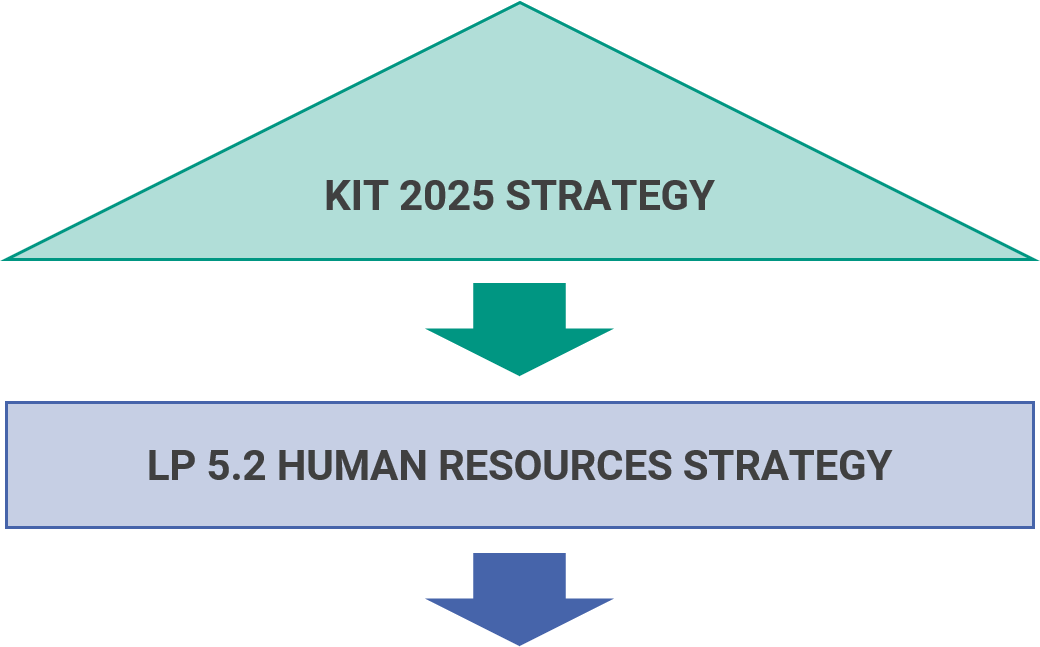General overview
In order to continue to excel in research, teaching and innovation, KIT faces up to the competition for the best minds. An important success factor here is contemporary human resources management, which is geared towards current developments on the labor market, for example by providing predictable and attractive career paths for scientific and science-supporting staff or innovative recruiting concepts, especially with regard to female and international scientists. The personnel strategy is intended to systematize, modernize and make transparent the instruments, processes and offers of the supporting personnel units at KIT. In order to be an attractive employer and thus ensure the success of science in research, teaching and innovation, the human resources work at KIT needs to be further developed. The Executive Board identified a total of seven key topics as particularly relevant for the development of a human resources strategy, which were transferred into sub-projects and worked on as part of the project:

Subproject 1: Personnel recruitment
Subproject 1 dealt with the orientation of recruitment at KIT. As a result, various fields of action were identified which are trend-setting for modern, successful and strategically oriented recruitment at KIT.
- Through suitable recruitment channels and target group-specific campaigns for professions with a shortage of skilled workers, KIT will achieve a quantitatively and qualitatively improved applicant situation in the future.
- A fast, transparent and largely digitalized recruitment process will give KIT a better chance of attracting applicants as employees.
- Special measures for targeted recruitment should lead to an increase in internationality, equal opportunities and diversity.
- A methodically sound personnel selection process ensures a suitable choice of applicants.
- By building up an employer brand and implementing personnel marketing measures tailored to this, KIT secures its ability to lead and work as well as its competitiveness in the scientific system.
Target groups:
- Managers and executives in administration and technology
- Employees in administration and technology
- Scientists (without professors)
Subproject 2: Junior staff development and specialist careers in administration and technology
Sub-project 2 dealt with personnel development for (junior) specialists and managers in administration and technology at KIT. As a result, a concept for systematic, succession-oriented potential development was developed.
- The personnel retreat format strengthens the organization's ability to act and manage personnel planning and development activities.
- By systematizing personnel development activities for managers in administration and technology, high-potential female employees are developed in a targeted manner and matched precisely with open vacancies in the organization.
- Increasing the transparency of development prospects and offers for specialists in administration and technology strengthens employee loyalty to KIT.
Target groups:
- Managers and executives in administration and technology
- Employees in administration and technology
Subproject 3: Specialist careers for permanent academic staff
Subproject 3 dealt with the career paths for permanent academics. As a result, a concept for the concrete implementation of a three-stage academic career system was developed.
- Transparent and plannable career stages and opportunities create a framework for orientation and prospects for scientists at KIT and serve as a basis for development discussions with the respective manager.
- Operationalized criteria make it possible to classify a large group of scientists in the career system.
- The differentiation based on career levels promotes the visibility of individual careers at KIT.
- Due to excellent career prospects, KIT is perceived as an attractive employer by the best minds in all career phases (from doctoral candidates to established scientists).
Target group
- Permanent scientists (without professors)
Subproject 4: Strategic personnel planning
Subproject 4 dealt with the strategic orientation of personnel planning at KIT. As a result, a strategic overall process of personnel planning was set up, which should serve as a framework for the procedure of personnel planning activities.
- The personnel planning process increases the transparency and controllability of personnel planning and development activities.
- The introduction of continuous annual appraisals initiated by PSE has improved personnel planning throughout the organization.
- The transparency of the modalities and possibilities for evaluating personnel planning data has been increased in order to promote a quicker overview of upcoming personnel measures.
- Work aids for all operational steps of personnel support create transparency for managers regarding personnel planning activities.
Target groups
- Managers and executives in administration and technology
- Employees in administration and technology
- Scientists to department heads
Subproject 5: Toolbox for Leaders
Subproject 5 dealt with the provision of standard leadership and management tools. As a result, a toolbox for leaders at KIT was created, which contains KIT-specific and success-critical instruments as well as guidelines and checklists.
- KIT's leadership tools reflect different types of leadership experience and the associated wide range of different needs.
- The toolbox simplifies and accelerates access to information for refreshing and expanding knowledge. Contact persons for specific topics can be found transparently.
- The toolbox offers pragmatic and practical access to leadership topics through short digital formats for communicating content and exchanging ideas with colleagues, which can be explored in greater depth with additional offerings such as traditional further training, coaching, etc.
- The toolbox is designed as a continuous improvement process to ensure that the tools are up to date.
Target groups
- Managers and executives in administration and technology
- Managers and executives in science
Subproject 6: Personnel management
Subproject 6 dealt with personnel management as a service at KIT. As a result, a transparent and high-quality service management was introduced in personnel management, in which potential, process and result orientation are decisive.
- The personnel management process overview is a visualization format and tool for criteria-based prioritization, enabling systematic clarification and documentation of personnel processes.
- It shows a way of gradually introducing transparent and high-quality service management in HR management, in which potential, process and results orientation are decisive.
- The focus is on customer needs and requirements in the sense of customer and relationship management.
Target group
- All employees, managers and executives
Subproject 7: Personnel issues of the future
Subproject 7 dealt with topics that will be important for future HR work. As a result, seven value-oriented theses on future HR topics were developed with a view to the social trends in HR work.
- With specific reference to KIT, the seven theses serve as a framework for reflection for the other sub-projects of the HR strategy as well as for further/future organizational development projects related to HR, or are incorporated into them.
Target group
- All employees, managers and executives

...dealt with the contemporary, successful and strategic orientation of recruitment at KIT.
to subproject 1
...dealt with the systematic, succession-oriented personnel development for (junior) specialists and managers in administration and technology at KIT.
to subproject 2
...dealt with the career paths for permanent scientists.
to subproject 3
...dealt with the strategic orientation of personnel planning at KIT.
to subproject 4
...dealt with the provision of standard leadership and management tools.
to subproject 5
...dealt with personnel management as a transparent and high-quality service at KIT.
to subproject 6
...dealt with topics and social trends that will be important for future HR work.
to subproject 7
A detailed version of the report is available on request. Contact: Natalie Hotz, PEBA
Download

